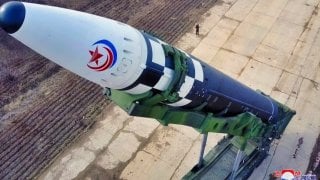Bruce Klingner

North Korean Spy Satellite Enhances Targeting Ability - Pyongyang successfully launched its first military reconnaissance satellite after two previous failures. North Korea has developed a robust missile arsenal but, until now, lacked a remote reconnaissance capability to identify, track, and attack U.S., South Korean, and Japanese military targets. The satellite’s capabilities, as well as whether it incorporated Russian technology, remain unknown.
North Korea announced the satellite surveilled U.S. military bases in Guam and vowed to launch several additional reconnaissance satellites “in a short span of time.” South Korea responded by suspending portions of an inter-Korean military agreement meant to prevent military clashes along the DMZ, raising tensions on the peninsula even further.
On November 21, Pyongyang conducted its third attempt at launching its Malligyong-1 military reconnaissance satellite onboard a Chollima-1 rocket. Previous launches in May and August 2023 failed to achieve orbit, but clearly, North Korea learned some valuable lessons. The South Korean navy salvaged some of the rocket and satellite debris from the ocean floor, enabling technical analysis, though the results have not been disclosed.
Kim Jong-un declared the regime’s intention to develop a military reconnaissance satellite in his January 2021 directive to the regime’s defense industry. Other delineated military projects included a solid-fuel ICBM, tactical nuclear warheads, hypersonic gliding flight warheads, and a nuclear-powered submarine.
North Korea reported an “important final-stage test” in December 2022 involving a mock satellite and subsequently released two poor-quality images of the Korean Peninsula. Experts denigrated the grainy, low-resolution images as being of far worse capability than commercially available imagery. Kim Yo-jong, the sister of North Korea’s leader, responded angrily that the test was to show the feasibility of the system rather than the eventual quality of the imagery.
In April 2023, Kim underscored the importance of having “several reconnaissance satellites on different orbits [for] securing real-time information about the hostile forces’ military scenario and moves.”
Ironically, North Korea’s most recent satellite launch occurred the same day the regime criticized South Korea and the United States for “recklessly” militarizing space, describing Seoul’s upcoming launch of its own reconnaissance satellite as an “extremely dangerous military provocation.”
It is possible that Russia provided technology to improve North Korea’s satellite launch capabilities in return for Pyongyang’s shipments of massive amounts of artillery ammunition to Moscow. During Kim’s September 2023 trip to Vladivostok, President Vladimir Putin hinted at providing military and technological support to North Korea.
Secretary of State Antony Blinken warned Russia was providing “technology and support” for North Korea’s military programs, though without elaborating on details. A South Korean military official told reporters that an 80-ton liquid fuel engine was transferred from Russia to North Korea even before the September summit. Russian engineers traveled to North Korea after the summit.
More likely, however, North Korea’s long-planned launch occurred too quickly after the Kim-Putin summit to have incorporated new Russian technology. Pyongyang announced it had developed the satellite and launcher “by its own efforts and technologies.” Pyongyang has frequently failed initial tests of new missile systems before eventually succeeding.
South Korea responded to the launch by partially suspending the 2018 Comprehensive Military Agreement, which then-President Moon Jae-in hailed as a major step in improving relations with Pyongyang. The accord established mutual risk reduction and confidence-building measures to reduce the potential for inadvertent military escalation.
However, the Yoon Suk Yeol administration declared that North Korea repeatedly violated the agreement and criticized provisions of the deal, which curtailed allied reconnaissance and military training activities. The Yoon administration announced it would suspend Article 1, Clause 3 of the agreement and restore airborne reconnaissance operations along the DMZ.
Any North Korean launch using “ballistic missile technology” is a violation of numerous UN resolutions, regardless of whether it is depicted as a civilian space launch. While China and Russia will veto approval of any new UN resolutions, the United States should step up its enforcement of U.S. and UN sanctions and work systematically with the international community to target North Korean violators, as well as entities in Russia, China, and elsewhere that facilitate Pyongyang’s transgressions.
The U.S. should also counter the growing North Korean military threat by strengthening security cooperation with allies South Korea and Japan, while encouraging these two allies to improve their bilateral cooperation. Last year, the U.S. resumed large-scale military exercises with South Korea and restarted rotational deployments of strategic assets, both after a four-year hiatus. Washington, Seoul, and Tokyo also restarted trilateral military exercises. These measures have augmented allied deterrence and defense capabilities.
The three nations should consider a return to pre-2018 training levels as a minimum requirement for future training schedules. Given the escalating growth in North Korean nuclear and missile forces, Washington should confer with Seoul and Tokyo on a training regimen that includes all military services and goes beyond ballistic missile defense and anti-submarine exercises to include air and ground forces.
The historic trilateral Camp David Summit in August paved the way for greater American-led military, economic, and technological cooperation against common security threats in the Indo-Pacific. The three leaders, however, will need to operationalize the extensive security agreements they reached as well as commit greater resources to offset advancing Chinese and North Korean military capabilities represented by this launch.
No comments:
Post a Comment